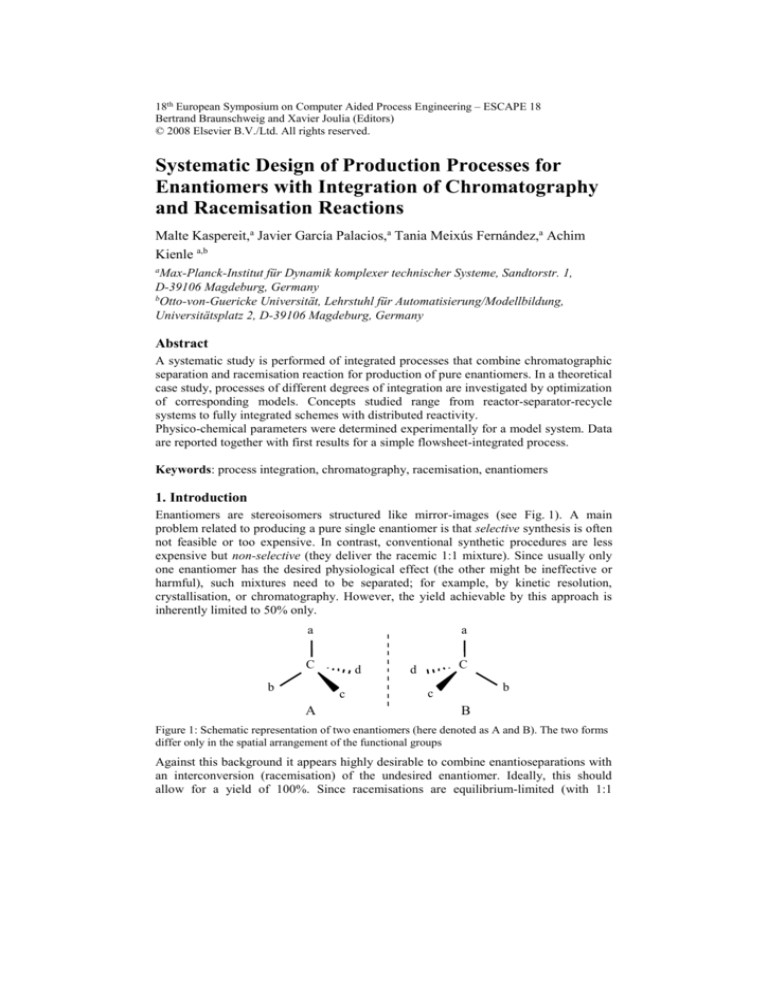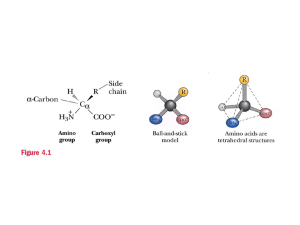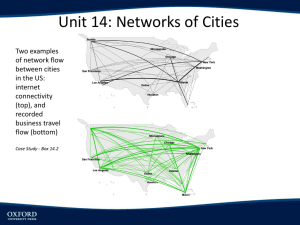
18th European Symposium on Computer Aided Process Engineering – ESCAPE 18
Bertrand Braunschweig and Xavier Joulia (Editors)
© 2008 Elsevier B.V./Ltd. All rights reserved.
Systematic Design of Production Processes for
Enantiomers with Integration of Chromatography
and Racemisation Reactions
Malte Kaspereit,a Javier García Palacios,a Tania Meixús Fernández,a Achim
Kienle a,b
a
Max-Planck-Institut für Dynamik komplexer technischer Systeme, Sandtorstr. 1,
D-39106 Magdeburg, Germany
b
Otto-von-Guericke Universität, Lehrstuhl für Automatisierung/Modellbildung,
Universitätsplatz 2, D-39106 Magdeburg, Germany
Abstract
A systematic study is performed of integrated processes that combine chromatographic
separation and racemisation reaction for production of pure enantiomers. In a theoretical
case study, processes of different degrees of integration are investigated by optimization
of corresponding models. Concepts studied range from reactor-separator-recycle
systems to fully integrated schemes with distributed reactivity.
Physico-chemical parameters were determined experimentally for a model system. Data
are reported together with first results for a simple flowsheet-integrated process.
Keywords: process integration, chromatography, racemisation, enantiomers
1. Introduction
Enantiomers are stereoisomers structured like mirror-images (see Fig. 1). A main
problem related to producing a pure single enantiomer is that selective synthesis is often
not feasible or too expensive. In contrast, conventional synthetic procedures are less
expensive but non-selective (they deliver the racemic 1:1 mixture). Since usually only
one enantiomer has the desired physiological effect (the other might be ineffective or
harmful), such mixtures need to be separated; for example, by kinetic resolution,
crystallisation, or chromatography. However, the yield achievable by this approach is
inherently limited to 50% only.
a
a
C
b
d
c
A
C
d
b
c
B
Figure 1: Schematic representation of two enantiomers (here denoted as A and B). The two forms
differ only in the spatial arrangement of the functional groups
Against this background it appears highly desirable to combine enantioseparations with
an interconversion (racemisation) of the undesired enantiomer. Ideally, this should
allow for a yield of 100%. Since racemisations are equilibrium-limited (with 1:1
2
M. Kaspereit et al.
equilibrium composition), process integration appears as viable concept. Here we will
investigate processes that combine (continuous) chromatography and racemisation.
2. Theoretical Case Study
2.1. Problem statement
Fig. 2 shows the task to be resolved by the processes considered here. The constraints
resemble a pharmaceutical problem, where purity requirements are very high and – due
to significant synthesis costs – a high conversion of the undesired form is desirable.
(continuous)
chromatography
50% A
50% B
99.9% A
≤
racemisation
AB
0.1% B
Figure 2: Schematic problem statement for the production of enantiomer A.
Subject of the study are integrated processes without waste stream that yield the desired
enantiomer with 99.9% purity. This corresponds to a conversion of 99.8%. Further, also
a less restrictive case is investigated (90% purity and 80% conversion).
Mail goal is here to identify general trends with respect to integrating continuous
chromatography and racemisation. Therefore, we consider a countercurrent of stationary
and mobile phases (i.e., True Moving Bed, TMB). While a feasible technology would
require column switching (i.e., Simulated Moving Bed, SMB), the development of such
system is out of scope here. Details on TMB/SMB systems are given in, e.g., [1].
2.2. Processes investigated
There is a rather large number of options to integrate continuous chromatography and
racemisation reaction. Fig. 3 shows a selection of possible schemes for the production
of the weaker adsorbing enantiomer A.
a)
S SR
F
A
c)
S
b)
S
F
A
d)
S
reaction
separation
F
SR
F
A
A
reaction & separation
Figure 3: Selected schemes for the production of A (F – feed, S – solvent, SR – solvent removed).
a) Reactor-separator-recycle system w/ four zones and solvent removal. b) Partially integrated
process w/ three zones and side reactors. c) Fully integrated process w/ four zones, distributed
reaction and solvent removal. d) Fully integrated scheme w/ three zones and distributed reaction.
Concerning the level of integration, classical flowsheet-integrated processes as reactorseparator-recycle systems (Fig. 3a) and the use of side reactors (“Hashimoto process”,
Systematic design of production processes for enantiomers
3
Fig. 3b) are considered. Furthermore, fully integrated schemes are possible (i.e.,
chromatographic reactors). While one option is to apply a constant reaction rate
parameter (i.e., Damköhler number, Da) throughout the unit, here we also consider the
option to use different values for Da in the individual zones (Fig. 3c). Finally, since
four-zone processes require a recycle (and the removal of solvent), also integrated
processes with three zones are studied (Fig. 3d).
Please note that here we focus on the schemes shown in Fig. 3 (and their corresponding
“counterparts” for the production of enantiomer B). However, there are more options.
For example, a four-zone Hashimoto system with internal recycles was suggested [2].
2.3. Process model and optimisations
All processes are modeled as series of countercurrent equilibrium cells. Parameters were
determined experimentally (section 3). A liquid-phase reaction is accounted for by
Da = (rate constant)x(cell volume)/(solid flow rate). Adsorption is described by the biLangmuir model. All equations were implemented in the simulation environment DIVA
[3]; details on the implementation of a largely analogous model can be found in [1,4].
The following set of performance parameters were used to evaluate each process:
ciout
VS
V SR
out out
,
PR
V
c
,
EC
,
SR
Pi out
i
PR
PR
c A c Bout
i ( A, B)
(1)
with purity Pi, productivity PR, specific eluent consumption EC, specific solvent
removal SR, and ciout as product concentrations. Note that PR can be scaled by the solid
volumetric flow (here equal to unity). Furthermore, solvent removal is assumed ideal
(i.e., no losses, obtains feed concentration level for higher concentrated solute) and that
side reactors (Fig. 3a and 3c) are in reaction equilibrium.
Optimisations were performed using an SQP algorithm in DIVA with EC as objective
function and the purity as nonlinear constraint. Variables were Da-numbers and the
relative zone flow rates, m j ( j=I...IV) (i.e., ratio of liquid and solid flow in each zone).
2.4. Results
Table 1 lists the obtained optimisation results for the process schemes in Fig. 3. As
expected, the conventional setup a) is a feasible option. It performs somewhat better for
the strongly adsorbed component B. The reason is that for producing A, the recycle load
is higher due to the strongly diluted stream of B at the extract port.
The Hashimoto process (b) was found to be infeasible for 99.9% purity. In fact, the
process is thermodynamically infeasible for the production of pure A. The scheme
achieves only low performance for 90% purity. This is in agreement with literature [2].
The hypothetical option of a fully integrated process with distributed reactivity (c)
allows for a significant improvement of process performance. This holds in particular
for component A, where SR and EC are strongly reduced. The main reason is that here
the required m I –value is 16% lower than in case (a); m I is even lower than the Henry
constant of B. The explanation is that any B in the reactive zone I also reacts to produce
A, which is desorbed more easily and transported towards the non-reactive zones. A
similar benefical effect (which is somewhat less pronounced) is found for m IV, which is
higher for the fully integrated schemes than for the flowsheet-integrated processes.
As a last option, integrated three-zone processes (d) were studied. These cannot achieve
a purity of 99.9%. However, a comparison of the results for 90% purity demonstrates a
significant potential. Considering that these schemes have no recycle or solvent
removal, they appear very attractive for tasks with limited purity requirements.
4
M. Kaspereit et al.
Table 1: Optimisation results for the process options shown in Fig. 3. The first column marks the
process scheme according for Fig. 3 and the target component. *) PR is scaleable by solid flux.
P
[%]
99.9
99.9
90.0
90.0
99.9
90.0
90.0
99.9
99.9
90.0
90.0
99.9
90.0
90.0
a) A
a) B
a) A
a) B
b)
b) A
b) B
c) A
c) B
c) A
c) B
d)
d) A
d) B
m I / Da I
[-]
23.47 / 19.33 / 19.47 / 18.03 / -
m II / Da II
[-]
11.54 / 14.71 / 10.58 / 12.57 / -
m III / Da III m IV / Da IV
EC
[-]
[-]
[l/g]
17.34 / 13.26 / 11.7
20.22 / 12.24 / 9.67
18.67 / 13.54 / 5.30
20.41 / 13.20 / 5.01
not feasible
18.97
19.85
13.63
16.8
20.51
13.54
14.84
12.2
-4
-18
-18
19.69 / 1039 11.69 / 10
17.24 / 10
12.26 / 10
8.54
22.69 / 10-16 14.62 / 10-11 20.55 / 10- 3 15.05 / 10 9 8.94
16.37 / 1068 11.25 / 10- 4 18.49 / 10-18 13.09 / 10-18 2.87
19.29 / 10-18 13.03 / 10-18 20.56 / 10- 4 15.54 / 10 9 3.61
not feasible (max. PA= 98.9%, max. PB = 99.4%)
16.65 / 4061 19.04 / 10-18 13.08 / 10-18
4.19
19.85 / 10-18 12.79 / 10-18 15.68 / 458
4.10
SR
[l/g]
9.54
5.56
3.50
2.13
PR
[g/l]*
0.87
0.77
1.12
0.96
0
0
3.87
4.40
0.93
0.36
0.32
0.47
0.87
0.85
1.14
1.04
0
0
0.85
1.02
3. Investigations for a model system
The model substance used in this work is chlorthalidone (CT), which has (in racemic
form) some use as a diuretic and anti-hypertensive drug. CT is stereolabile (i.e., it can
be racemised rather easily) [5]. Chemicals were purchased from Merck (Darmstadt,
Germany), with the exception of CT (Sigma Aldrich, Steinheim, Germany).
3.1. Chromatographic parameters
Experiments were performed using an analytical column (200x4mm) with a chiral
stationary phase (Nucleodex -OH, Macherey-Nagel, Germany) at 10°C with a flow
rate of 0.5 ml/min. The mobile phase was 40/60 (v/v) methanol/water, 50mmol
triethylamine at pH=5.0 (acetic acid). Conventional HPLC equipment was applied
(Knauer, Berlin, Germany and DIONEX, Idstein, Germany).
The porosity was determined from an acetone pulse. NTP-values were determined from
small injections of 0.4 g/l racemic CT in mobile phase (corresponds to solubility).
0.4
0.3
c i [g/l]
t R,i [min]
16
14
12
10
0.2
0.1
0
0.05
0.1
0.15
c i [g/l]
0.2
0
10
20
30
t [min]
40
50
Figure 4: Determination of adsorption isotherms. Left – perturbation data and corresponding fit
by isotherm model (lines). Right – overloading experiments (points, injection volume: 0.13...5ml)
and simulations (lines).
Systematic design of production processes for enantiomers
5
Adsorption isotherms of the bi-Langmuir-type were measured (see Tab. 2). An initial
set of parameters was obtained by the perturbation method [6]. Subsequently, a “peak
fitting” approach based on the equilibrium-dispersive model was used for refinement
(for details, see [4]). Fig. 4 shows a good agreement between models and experiments.
3.2. Kinetics of racemisation reaction
The thermal racemisation of CT was investigated using batch experiments. Since CT is
available only in racemic form, first purified fractions (ca. 2ml each) were obtained
from HPLC runs, which then were allowed to racemise at different temperatures (15°C
to 60°C). Samples were taken for HPLC analysis. Fig. 5 (left) shows an example data
set.
-6
4
-8
3
ln k
c i [10-5 mol l-1]
5
2
-10
-12
1
0
0
100
200
t [min]
-14
29
300
31
33
1/T [10-4 K-1]
35
Figure 5: Left – example of a batch racemisation experiment at 40°C. Symbols: concentrations of
the enantiomers (HPLC analysis). Lines: calculated from Eq. (2). Right – Arrhenius diagram
obtained from batch experiments between 15°C and 60°C.
Data were fitted by adjusting the rate constant of the first-order kinetic expression
c1 (t )
c10 c20 0 c10 c20
exp 2kt
c1
2
2
(2)
Fig. 5 (right) shows the resulting Arrhenius plot from which activation parameters were
determined (Tab. 2). Fig. 5 (left) shows the resulting fit obtained from these parameters
and the rate expression (2). A good agreement was obtained for all experiments.
Table 2: Summary of experimentally obtained parameters for chromatography and racemisation.
Adsorption isotherms
I
qS / qS
II
biI / biII
length / diameter / porosity
number of theoretical plates
Racemisation kinetics
B
A
94,17 / 0,244
0,207 / 6,395
0,141 / 3,192
20cm / 0,4 cm / 0,796
680
k0 =3,771012 s-1 / EA = 99,9 kJ/mol
3.3. Recycling chromatography combined with thermal racemisation
The above theoretical study shows that it is useful to fully integrate racemisation and
continuous chromatography. However, corresponding technology is not yet available.
Since the conventional reactor-separator setup was demonstrated to be feasible, as a first
step single-column recycling chromatography was investigated experimentally. A
thermostatted CSTR (40°C) was connected to the column in a recycle setup. A part of
the front of each chromatogram was collected as product A; the rest was recycled to the
PR [g/d/l]
6
M. Kaspereit et al.
reactor. To maximise productivity, the process was operated in “touching band” mode.
Due to dispersion in the system, the product average product purity achieved was 95%.
Reactor concentrations remained close to the 1:1 mixture. Since no solvent removal
could be used at this small scale the process expectedly suffered from strong dilution.
100
5
0
0
10
cycle
20
100
yield [%]
10
EC [l/g]
PR [g/d/l]
15
50
0
0
10
cycle
20
50
0
0
10
cycle
20
Figure 6: Performance of single-column recycling with (open symbols) and without solvent
removal (filled) in comparison to an SMB-based process with ISR in steady state (dashed lines).
Fig. 6 shows performance predictions obtained with the equilibrium-dispersive model
for such single-column recycling with and without ideal solvent removal (ISR). The
same requirements were used as in section 3. The process is basically infeasible without
ISR. Also shown is the steady state performance of an SMB-based process (6 columns,
ISR, cf. Fig. 3a). As is often found, the SMB process achieves a lower productivity, but
at the same time allows for significantly lower solvent consumption.
4. Summary
For the production of pure enantiomers from racemic mixtures it is desirable to combine
the enantioseparation with an interconversion (racemisation) of the undesired form.
Corresponding concepts that integrate chromatography and racemisation were studied
theoretically, ranging from classical flowsheet integration to fully integrated processes
with distributed reactivity. The latter options – although being hypothetical – have a
significantly improved performance. However, it was also found that internal recycles
and solvent removal are necessary if high purity is required.
Parameters for racemisation kinetics and chromatographic separation of a model system
were determined experimentally. Model predictions and first-stage experiments were
performed for flowsheet integrated processes. Single-column systems were found to be
an interesting alternative to SMB-based schemes.
Current work focuses on theoretical investigations of further process schemes under a
broader range of product and problem specifications. Furthermore, technological
options are studied for fully integrated processes and intermediate solvent removal.
References
[1] M. Kaspereit et al., J. Chromatogr. A (2007) 2 – 13
[2] T. Borren, Untersuchungen zu chromatographischen Reaktoren mit verteilten
Funktionalitäten, PhD thesis, VDI Verlag, Düsseldorf, Germany, 2007
[3] M. Mangold et al., Chem. Eng. Sci. 55 (2000) 441 – 454
[4] M. Kaspereit, Separation of Enantiomers by a Process Combination of Chromatography and
Crystallisation, PhD thesis, Shaker Verlag, Aachen, Germany, 2006
[5] K. Cabrera et al., J. Chromatogr. A 731 (1996) 315 – 321
[6] C. Blümel et al., J. Chromatogr. A 865 (1999) 51 – 71.








